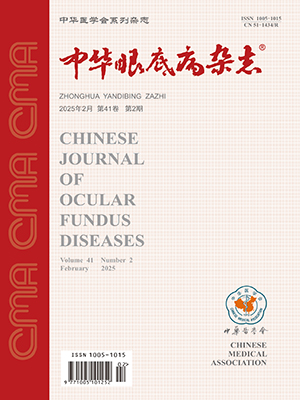| 1. |
Shields JA, Shields CL, Honavar SG, et al. Classification and management of Coats disease: the 2000 Proctor Lecture[J]. Am J Ophthalmol, 2001, 131(5): 572-583. DOI: 10.1016/s0002-9394(01)00896-0.
|
| 2. |
Shields JA, Shields CL, Honavar SG, et al. Clinical variations and complications of Coats disease in 150 cases: the 2000 Sanford Gifford Memorial Lecture[J]. Am J Ophthalmol, 2001, 131(5): 561-571. DOI: 10.1016/s0002-9394(00)00883-7.
|
| 3. |
Gomez Morales A. Coats' disease. Natural history and results of treatment[J]. Am J Ophthalmol, 1965, 60(5): 855-865. DOI: 10.1016/0002-9394(65)92006-4.
|
| 4. |
Ruben M, Yaghy A, Park CH, et al. Neglected Coats disease[J/OL]. J Pediatr Ophthalmol Strabismus, 2020, 57: e82-e85[2020-10-20]. https://www.ncbi.nlm.nih.gov/pubmed/33090232. DOI: 10.3928/01913913-20200818-01.
|
| 5. |
Karacorlu M, Hocaoglu M, Sayman Muslubas I, et al. Long-term anatomical and functional outcomes following vitrectomy for advanced Coats disease[J]. Retina, 2017, 37(9): 1757-1764. DOI: 10.1097/IAE.0000000000001415.
|
| 6. |
Mano F, Matsushita I, Kondo H, et al. Vitrectomy and external drainage of subretinal fluid containing high concentration of vascular endothelial growth factor for advanced Coats disease[J/OL]. Sci Rep, 2021, 11(1): 19333[2021-09-29]. https://pubmed.ncbi.nlm.nih.gov/34588604/. DOI: 10.1038/s41598-021-98968-9.
|
| 7. |
Zhao Q, Peng XY, Chen FH, et al. Vascular endothelial growth factor in Coats' disease[J/OL]. Acta Ophthalmol, 2014, 92(3): e225-e228[2013-06-13]. https://pubmed.ncbi.nlm.nih.gov/23764089/. DOI: 10.1111/aos.12158.
|
| 8. |
Zhang J, Jiang C, Ruan L, et al. Associations of cytokine concentrations in aqueous humour with retinal vascular abnormalities and exudation in Coats' disease[J]. Acta Ophthalmol, 2019, 97(3): 319-324. DOI: 10.1111/aos.13971.
|
| 9. |
Jiang L, Qin B, Luo XL, et al. Three-year follow-up of Coats disease treated with conbercept and 532-nm laser photocoagulation[J]. World J Clin Cases, 2020, 8(24): 6243-6251. DOI: 10.12998/wjcc.v8.i24.6243.
|
| 10. |
Zhang L, Ke Y, Wang W, et al. The efficacy of conbercept or ranibizumab intravitreal injection combined with laser therapy for Coats' disease[J]. Graefe's Arch Clin Exp Ophthalmol, 2018, 256(7): 1339-1346. DOI: 10.1007/s00417-018-3949-1.
|
| 11. |
Li S, Deng G, Liu J, et al. The effects of a treatment combination of anti-VEGF injections, laser coagulation and cryotherapy on patients with type 3 Coat's disease[J]. BMC Ophthalmol, 2017, 17(1): 76. DOI: 10.1186/s12886-017-0469-4.
|
| 12. |
Yang Q, Wei W, Shi X, et al. Successful use of intravitreal ranibizumab injection and combined treatment in the management of Coats' disease[J]. Acta Ophthalmol, 2016, 94(4): 401-406. DOI: 10.1111/aos.13067.
|
| 13. |
Zheng XX, Jiang YR. The effect of intravitreal bevacizumab injection as the initial treatment for Coats' disease[J]. Graefe's Arch Clin Exp Ophthalmol, 2014, 252(1): 35-42. DOI: 10.1007/s00417-013-2409-1.
|
| 14. |
阮露, 黄欣, 江睿, 等. 间接检眼镜下激光光凝治疗青少年型Coats病[J]. 中华眼底病杂志, 2014, 30(1): 42-45. DOI: 10.3760/cma.j.issn.1005-1015.2014.01.011.Ruan L, Huang X, Jiang R, et al. Juvenile Coats disease successfully managed with green diode laser using indirect ophthalmoscope[J]. Chin J Ocul Fundus Dis, 2014, 30(1): 42-45. DOI: 10.3760/cma.j.issn.1005-1015.2014.01.011.
|
| 15. |
Reichstein DA, Recchia FM. Coats disease and exudative retinopathy[J]. Int Ophthalmol Clin, 2011, 51(1): 93-112. DOI: 10.1097/IIO.0b013e318200de51.
|
| 16. |
Schefler AC, Berrocal AM, Murray TG. Advanced Coats' disease. Management with repetitive aggressive laser ablation therapy[J]. Retina, 2008, 28: S38-41. DOI: 10.1097/IAE.0b013e318163cd7c.
|
| 17. |
Giannakopoulos M, Drimtzias E, Panteli V, et al. Intravitreal ranibizumab as an adjunctive treatment for Coats disease (6-year follow-up)[J]. Retin Cases Brief Rep, 2017, 11(4): 339-343. DOI: 10.1097/ICB.0000000000000363.
|
| 18. |
Wang Y, Fan H, Gao K, et al. Levels of cytokines in the aqueous humor guided treatment of refractory macular edema in adult-onset Coats' disease[J]. BMC Ophthalmol, 2020, 20(1): 261. DOI: 10.1186/s12886-020-01474-1.
|
| 19. |
Kam AW, Hui M, Cherepanoff S, et al. Rapid "epiretinal membrane" development following intravitreal bevacizumab for Coats' disease[J]. Am J Ophthalmol Case Rep, 2018, 11: 75-77. DOI: 10.1016/j.ajoc.2018.06.002.
|
| 20. |
Ramasubramanian A, Shields CL. Bevacizumab for Coats' disease with exudative retinal detachment and risk of vitreoretinal traction[J]. Br J Ophthalmol, 2012, 96(3): 356-359. DOI: 10.1136/bjophthalmol-2011-300141.
|
| 21. |
Levinson JD, Hubbard GB, 3rd. 577-nm yellow laser photocoagulation for Coats disease[J]. Retina, 2016, 36(7): 1388-1394. DOI: 10.1097/IAE.0000000000000874.
|
| 22. |
Shapiro MJ, Chow CC, Karth PA, et al. Effects of green diode laser in the treatment of pediatric Coats disease[J]. Am J Ophthalmol, 2011, 151(4): 725-731. DOI: 10.1016/j.ajo.2010.10.024.
|
| 23. |
Nowara M, Fouad YA, Abdel Aziz I, et al. Experience with intravitreal ranibizumab as an adjunct to ablation therapy in eyes with exudative Coats' disease[J]. Clin Ophthalmol, 2021, 15: 367-373. DOI: 10.2147/OPTH.S293030.
|




